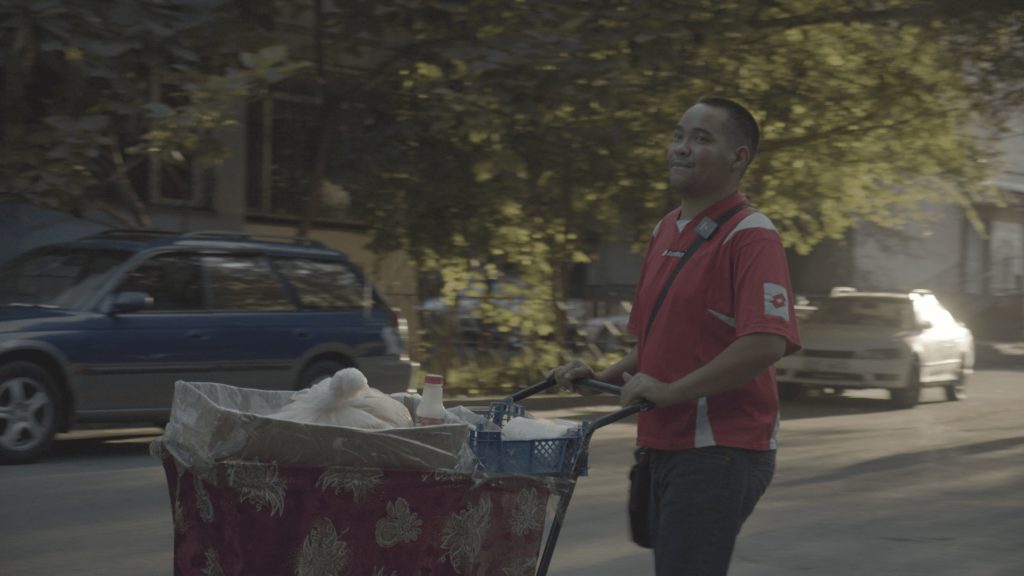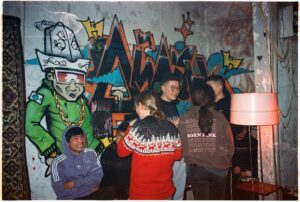A heated debate continues in Kazakhstan’s film industry around redistribution of the resources among the titular creative elite, privileged officials, and monopolists of the field. The industry, which depends entirely on state funding, is paralysed by unscheduled audits and constant postponements. Filmmakers speak out against each other, finding neither collegiality nor professional solidarity. The only possible way out of the corruption scandals is to focus on the films produced by this film industry, which remain permanently invisible to the Kazakhstani audience.
In this series of articles, directors and producers Kristina Mikhailova, Dana Sabitova and Almira Ismailova take an in-depth look at Kazakhstani documentaries from artistic, production, industrial and social perspectives, and discuss with the directors the very conditions of existence of their breakthrough films.
Kristina Mikhailova: We act as a “Women make docs” collective and, being documentary filmmakers ourselves, we decided to reflect on the work of our colleagues together and to bring it into the sphere of public discussion. Our country constantly lacks professionals who write about cinema, and especially about documentaries. We read short audience reviews, near-professional personal reflections, and impressions, but very few authors try to analyse the films themselves and their inner potential, rather than solely the influx of cash for the creative industry. Over the last couple of years, we have taken part in several documentary filmmakers’ associations, which has given us a clear understanding that contemporary auteur documentary filmmaking in Kazakhstan exists under very specific conditions. One of the aims of this series of articles is to try to make sense of this complexity in its entirety, without rejecting or neglecting it. Why should audiences make an effort to find and watch Kazakhstani documentaries that you will never see in the cinema?
Almira Ismailova: Just a few years ago, when documentaries were becoming more and more relevant and spectacular all over the world, when creative documentaries were winning Grand Prix at Class A festivals (“Honeyland” Sundance, 2019 and “On the Adamant” Berlinale, 2022), when documentaries were entering live action territory and winning Oscars (“Nomadland” Chloé Zhao, 2020), Kazakh cinema continued to spew the templates of traditional TV format. However, the year 2022 became a time of transformation for Kazakh documentary filmmaking and the emergence of artists in it. While watching the latest films that have come out, we have seen some trends that are important to pay attention to.
Kristina Mikhailova: Our focus is on four key films: “Jel paıda bolǵan jer” (“The place where the wind starts”) by Dzhanibek Murtazin and “Voice of the Glacier” by Yadykar Ibraimov, both funded by the State Centre for National Film Support, as well as “Sweet Milky Corn” by Aizhan Kassymbek and “Alaqan” (“The palm”) by Aida Adilbek, both of which were created by independent authors. These films stand out in the stream of niche documentaries, available to Kazakhstani viewers on YouTube or television, which are characterized by their exceptionally informative presentation style, acute social agenda and ‘talking heads’. Whereas, documentary cinema in the world is an international language with unique tools for making sense of reality. Why do viewers trust documentary more and more? Because documentary is taking the form of a revelation, becoming an increasingly intimate artistic statement. Finally, we can say that almost radical artists have appeared on the documentary scene in Kazakhstan, who are not just fast melting state or scarce independent grant money, but are developing their own distinctive style, questioning hierarchies, and revolutionizing everyday life.
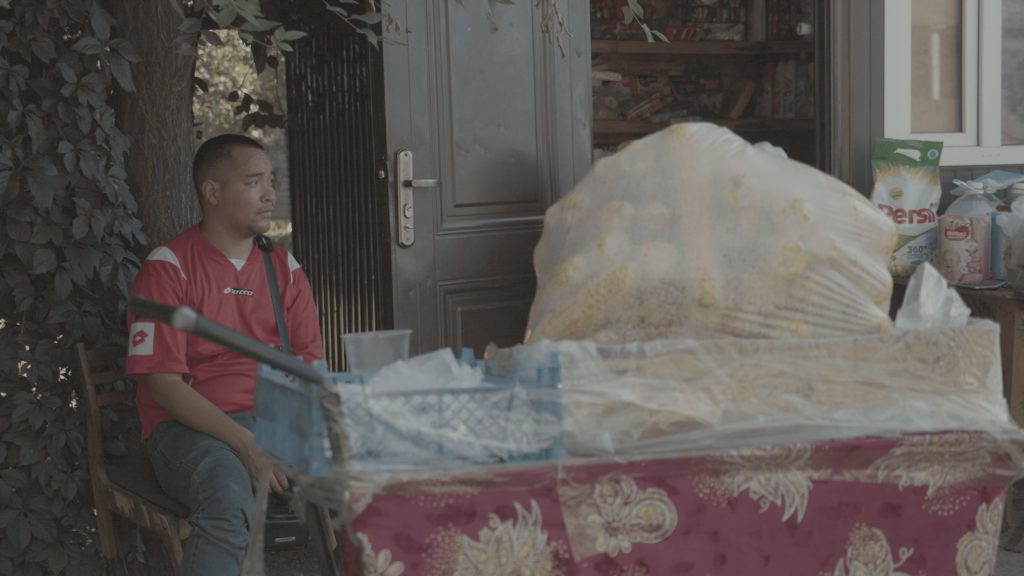
Almira Ismailova: We will start with Aizhan Kassymbek’s “Sweet Milky Corn.” The film’s genre is that of an acute social documentary. The main character, Kairat, is an orphan boy who suffered a head injury as a child. He, like Odysseus, wanders the residential neighbourhoods of Almaty and sells sweet milky corn. He dreams of getting a house and believes in people’s ability to see him as an equal. We are used to the fact that in fiction films, the hero is plagued by conflicts invented by the screenwriter. In a documentary, the protagonist comes to the filmmaker with a set of conflicts. Depending on which subject the director focuses on, these “sores” are revealed. Aizhan, why, for you, is Kairat the protagonist of a documentary?
Aizhan Kassymbek: In documentary cinema, I think the most important thing is to find the main character of the film. Kairat always lived next door to me. I used to hear him walking around the yard every summer and shouting: “Sweet Milky Corn!” I decided to meet him. When I talked to him, I saw some sort of infinite kindness and warmth from a man whose life has been doomed to suffer since birth. He is in a very difficult situation. In addition to living in poverty, he was abandoned as a child and has a disability. Due to a head injury, he was placed in a mental facility and was there for about 8 years. It was a great shock and revelation for me to stand next to a man who has had such a difficult life and that he sees the world as a nice place and still has some hopes, some dreams. He doesn’t want to achieve something huge or high up. No, he just wants to have a business, and that business will be built on selling corn. I realized I wanted to make a film about him because he is a unique person.
Almira Ismailova: Aizhan’s work is a striking example of a character-driven documentary, and Kairat is a very lively, active, and enterprising character. He is busily writing down his income and expenses in a notebook, making plans on how to spend it. Next to him, we see a domineering, strong woman, his adoptive mother. She peels corn and smokes a thick cigarette majestically. Aizhan, as a director, apotheosizes her majesty. The mother says that when Kairat gets a flat from the state, they will let him live alone. In doing so, Aizhan offers the viewer a world where not everything is so obvious. We understand that relationships in the family are complicated and confusing, and the likelihood of getting a flat tends towards zero. The author leaves us alone with these thoughts; the understatement becomes the very way the director interacts with the viewer. This understatement emotionally charges the story.
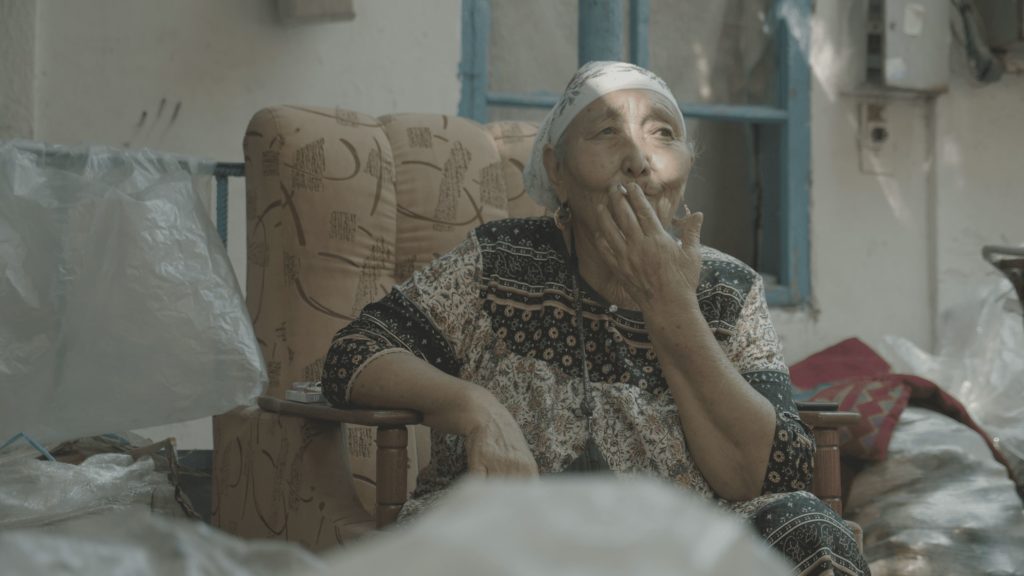
Kristina Mikhailova: Aizhan’s character is a typical hero of a social story, but we see that the author has a very atypical attitude towards him as a hero of tragedy. Kazakh documentaries, as well as documentaries from the entire post-Soviet space, always position themselves negatively towards tragic events. The viewer feels pity for unhappy people because they are doomed to feel pity. Without any alternative optics, without any artistic comprehension. This may sound harsh, but this way the authors are engaged in a historical falsification, an idealization of the suffering tragic hero. Such falsification evokes a natural emotional rejection, especially in documentary films, because we, as viewers, expect to see a documentary reality captured on the screen, but all we see is a false documentary interpretation. I think there have been so many documentaries of this kind, especially on television, that it is very difficult to overcome this bias emotionally.
But Aizhan has succeeded. It’s amazing, but in the two feature-length films that Aizhan has had time to make in her ten-year career as a director, I fully identify with the characters who appear on the screen. I’m talking about the films “Ot” (“Fire”) and “Sweet Milky Corn”, where the main characters are middle-aged men who struggle daily to survive on the outskirts of the city. And I differ from them. We are in completely different positions, but after each film I am left with the feeling that Aizhan has made a film about me again, about my neighbors from the outskirts and center of Almaty, about my fellow filmmakers who are forever in debts and without the minimum social security. That’s why we put the title “The film, in which everyone recognizes themselves”. Aizhan doesn’t idealize Kairat. In one scene, his adoptive mother says, “Sometimes he shouts, ‘Shut your mouth!’. I am afraid of him in these moments. Kairat is a big lad, he could hit you. He won’t face consequences, he has a yellow card [card for the mentally disabled].”
Guided by the typical logic of creators of “pity” documentaries, this scene simply should not be in the film. But Aizhan has this scene, and for me, it reveals the reverse side of the character’s infinite kindness. We ponder what Kairat’s submissive acceptance of his own extreme oppression has transformed into.
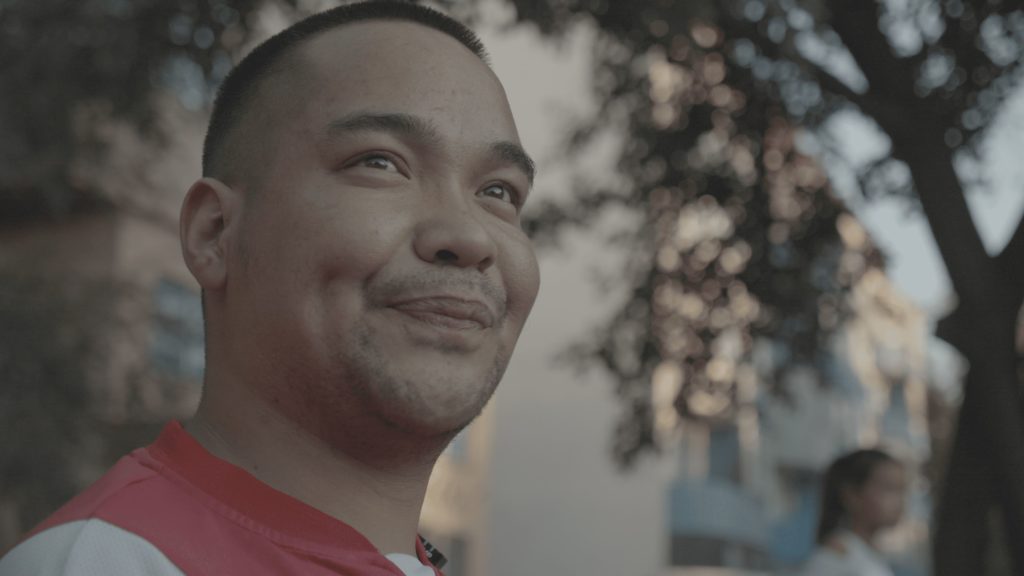
Almira Ismailova: Yes, indeed, this kind of hero was impossible ten years ago. Suffice it to compare Kairat with the heroes of Adilkhan Yerzhanov’s “Constructors” and “The Owners”. They do not know how to survive in the world of capitalism, corruption, and lawlessness, infinitely imitating life instead of living. Kairat has the courage to face his fears and is excited by the very will to live. There is no blind obedience to fate in him; he is so strong and inventive that he is able to gamble with destiny. Kairat barely makes ends meet, but he insists that selling corn is a business, treating his humble livelihood as an entrepreneur’s income. This choice is probably driven by desperation, but Aizhan presents Kairat as an active, resilient man with an entrepreneurial streak. She is keenly aware of Kairat as a hero of our time.
Aizhan also raises the question of how people with disabilities are treated in Kazakh society. One of the directors of the orphanage dissuaded Kairat’s adoptive mother from taking him. “Jyndy boldy deıdi da“ [“He said he’s gone crazy”], says the foster mother regarding one case of Kairat’s placement in a psychiatric hospital. The woman understands in her gut how much Kairat needs family and freedom. In another scene, the funicular trip to Kok-Tobe, Kairat’s friend tells him how he fought in court to get his legal capacity back. We see how the seemingly sensitive and commonly used word ‘special’ offends such people.
Aizhan’s camera captures the vibrant matriarchal beginnings of Kazakh society. We literally feel the tight rope of Kairat’s relationship with his mother trembling, we realise her importance to Kairat. Throughout the film, they experience a spectrum of emotions: tenderness, fear, and despair. In the final scene at the wedding, the two of them sit together on a bench in the courtyard, in identical poses, and smoke cigarettes. They are calm and at peace. They are becoming equal.
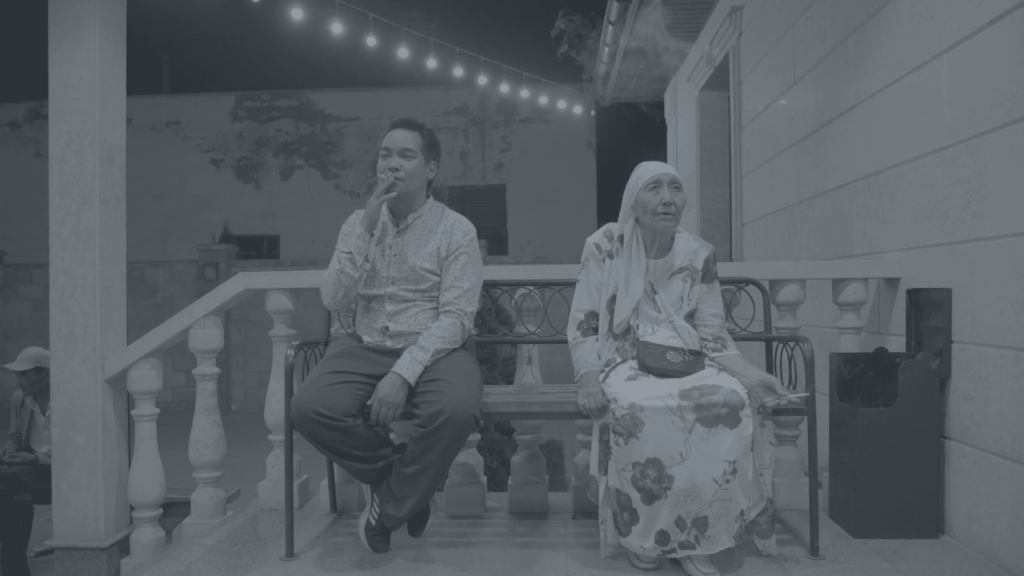
Also notable is the shot in which the three grannies go on patrol in flip-flops and colourful dresses. Aizhan had a wide shot of their movement along houses crossing the road, along vegetable stalls and small shops. In the scene finale, they walk away into the archway between the houses. This scene is musically intensified, brought to the level of absurdity of Jim Jarmusch, with whom Aizhan has been compared in the pages of Variety. With this scene, Aizhan confesses her love for the sometimes unsightly and grey but important for her Almaty. She places her characters in a non-ideal but dear and cosy atmosphere of “mikry” (residential neighbourhoods), where life flows and people eat sweet milky corn.
Dana Sabitova: Speaking of the author’s background, Aizhan has established herself as a director of feature films. Her debut feature film, “Ot” (“Fire”), premiered at the Busan International Film Festival in South Korea. “Fire” tells the story of a “kedei jomart”, a generous poor man, Tolepbergen, who embodies the stubborn, unhappy, resilient Kazakh people. This film was funded by the State Centre for the Support of National Cinema (SCSNC) in 2020, with a budget of thirty-four million tenge (£60,000). For a feature film with 25 shooting days, this is an unbearable minimum, with almost no sufficient salary for the film crew. State financing involves enormous bureaucracy and tight deadlines, which unfortunately only apply to filmmakers and not the State Centre. The deadlines for the payment of tranches to film workers by the SCSNC are routinely violated and not regulated by any supervisory authority. Apparently, this is why when Aizhan started working on her documentary debut, she did not consider the possibility of state public funding.
Aizhan Kassymbek: We started shooting in 2018 with very little funding, which was only enough to rent a camera. The shooting lasted for two years. For two years, whenever we had a bit of money, we ran to shoot Kairat. I didn’t expect any help from the government. To be honest, I didn’t even know where to apply with such an idea, it was 2018. And even now I don’t know where to apply. Yes, you can go to the SCSNC, but it’s a very long wait and the story slowly disappears. It was very important for us to capture some key moments in the life of the protagonist.
Documentary filmmaking works with a complicated system. You first write a script, fill out applications, look for a budget, apply to local and international funds, and only then do you start shooting. Everything takes a very, very long time. That’s where the big difficulty is because everything disappears: the character, the situation. To be honest, I still don’t know how you can work on a documentary when you know all this stuff.
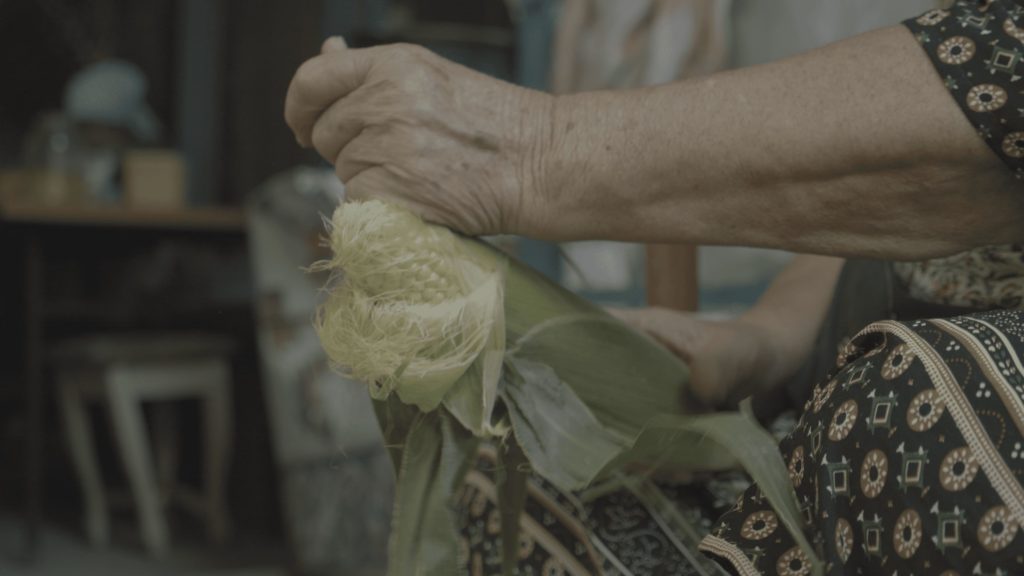
Kristina Mikhailova: I heard from Aizhan several times that she quits cinema. But I’m glad it always turned out to be a joke filled with despair and sadness. Of course, I completely share the bewilderment as to why directors and producers continue to work within this system, which has been designed, seemingly on purpose, so that documentary filmmakers have no chance to make their voices heard. This seems quite logical, because a good documentary film is a wide discussion about our society at international film festivals, on major streaming platforms. If Aizhan’s film criticizes the injustice of the social hierarchy existing in Kazakhstan, asks uncomfortable questions and claims to be a politicized artistic event, then the state structures that create and multiply official narratives create conditions that make it impossible for Aizhan’s film to exist.
But this film does exist. We write about it; we look for ways to overcome this situation. A distinctive feature of such social films is the potential impact factor. Special international funds create a safe space for this kind of cinema, providing funding. But you can imagine how competitive they are. And the important fact here is that Aizhan’s story is extremely local. It has to be seen by a Kazakh audience; it’s made for our society. I especially want to point out that with regard to “pity” gruesome cinema there was a stereotype that the authors are motivated by greed, that it is a cheat code to get to international festivals, that the authors make films about our depressive reality in order to gain favor with international institutions and festivals. That’s not true, this is a myth! There isn’t even an equivalent of the word “chernukha” in English [literally – “blackness”, metaphorically – “nastiness”]. This kind of cinema is not a popular product on the international market. It is up to Kazakhstani audience to support Aizhan’s next film by co-opting and creating alternative avenues of financing. Because Aizhan, in turn, is creating a cinema to be a screen-sized mirror for our society.
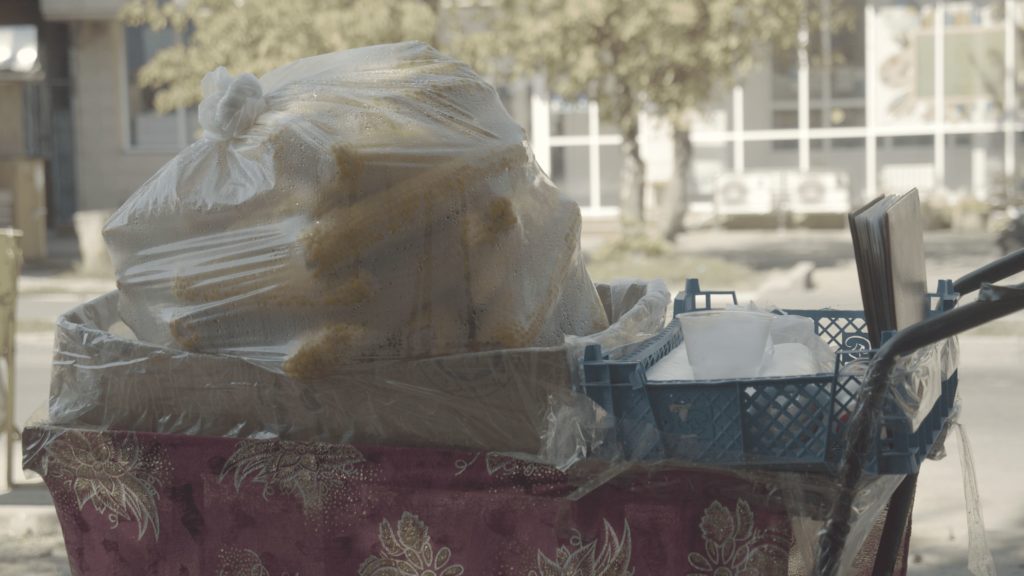
Dana Sabitova: As a producer who works directly with the crew and manages the production processes, I can’t help but talk about the crew. Aizhan created her film in close tandem with cinematographer Aigul Nurbulatova, whose work was in competition at this year’s Cannes Film Festival. It is a very special and personal experience, with the director following the characters through the film and the cinematographer controlling the third eye, shadowing them. It is through this third eye of the cinematographer that the audience can see the film. Aigul has filled the film with a special space, where we can breathe in the atmosphere of a “Baraholka” flea market or a neighbourhood in Almaty. This atmosphere is almost non-existent in the space of Kazakh films, as if “Baraholka” does not exist in our reality at all.
Going back to the question of limited funding opportunities, the total budget of the film does not exceed one million tenge (£1,750), including a cash prize of $1,000 from Internews at the AÝT Central Asia pitching of the Qara Film Fest documentary festival in 2021. It’s safe to say that this is a utopian budget. Only the director’s stubborn focus on her character and a burning desire allowed this film to be born. The cinematographer and the director worked for free.
In documentary filmmaking, it is impossible to get the whole production budget at once, as it is in feature films or TV series, for example. Documentaries are made gradually as money comes in for the different stages of production. Yes, it does take a very long time, and it is impossible to get funding from foreign institutions without some kind of pre-production, without visual material for the future film. In the European film industry, this problem is solved by separate funds that only finance the initial development and research of the project. This takes one or two years of fully paid work. In most cases, the Kazakhstani production scheme of the State Centre offers three months for the full production, from the idea to finished DCP. That means that if you need more, the development and preliminary research should be made by the director and producer for free, with no salary or resources. Theoretically, it is possible to start work on a film with state public funding only for the development. But, firstly, for some reason such precedents have not happened. Secondly, in this case, 100% of copyright for the film would be owned by the Ministry of Culture and Sports of Kazakhstan. Subsequently, not being owners of the rights, the authors of the film cannot apply for further financing to any foreign fund.
It’s a vicious circle. So, it turns out that while the heart and soul burns for the cinema, the authors either agree to impossible deadlines or shoot independently, with practically no budget. That’s what Aizhan did, too. In both cases, this leads to directors and producers to burn out quickly. They have no energy left to think about how these films will reach the audience, distribution, sales and film festivals. Aizhan could also shoot the first material on her own, and then find an international co-producer and participate in international pitchings. But this option only works if the author is prepared to work on the film under risky conditions for at least five years, the first three of which are free of charge.
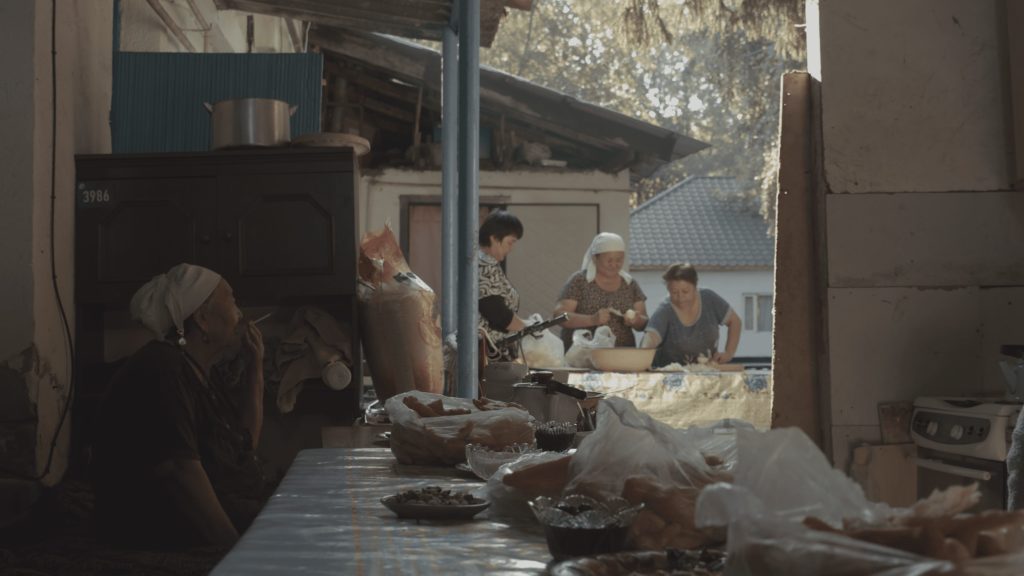
Kristina Mikhailova: We want to talk to the audience about this film because, although it addresses a common acute social theme – people living in difficult social conditions – it transforms this oppressive reality with the unbearable lightness of its style. Aizhan Kassymbek treats her characters with a degree of love where pity and sympathy are expressed through great respect for another person’s sense of dignity, as opposed to the arrogant fixation of another person’s grief. The step from political exploitation of the subject to artistic and political reflection is precisely why every Kazakhstani citizen will recognize themselves in “Sweet Milky Corn.”
For more news and analysis from Central Asia, follow us on Twitter, Facebook, Telegram, Linkedin or Instagram.
This article was first published by Vlast.kz
Translated by Anna Wilhelmi
Edited by Abby Scripka
Visual materials are provided by the ‘Women make docs’ collective
 Sweet Milky Corn: the film, in which everyone recognizes themselves
Sweet Milky Corn: the film, in which everyone recognizes themselves 
